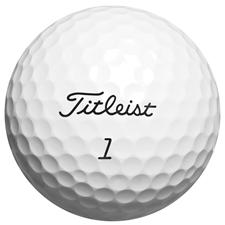 Of all the things that have changed in golf over the last 20 years, the golf ball is one of the most dramatic. Along with the large-headed drivers, golf balls have totally changed the way golf is played. Just look at how much farther the pros hit the ball these days. The new golf balls are one of the major reasons for that.
Of all the things that have changed in golf over the last 20 years, the golf ball is one of the most dramatic. Along with the large-headed drivers, golf balls have totally changed the way golf is played. Just look at how much farther the pros hit the ball these days. The new golf balls are one of the major reasons for that.
Under the Rules of Golf, a golf ball can weigh no more than 1.620 oz (45.93 grams), have a diameter not less than 1.680 in (42.67 mm), and must perform within specified velocity, distance, and symmetry limits.
Under the reality of golf, there is no part of golf that has more effect on our games. It’s the only “tool” of the game that we use on every hole. Or at least until we lose it.
It is also the part of the game that has probably changed the most in the last 10 years. Modern balls bare little resemblance to the balls of 20 years ago. They are so much better it’s scary. They go farther and they last longer and they stop quicker — even for the average golfer. And compared to 100 years ago… well… read on.
History
Wooden golf balls were used until the early 17th century, when the featherie ball (right) was invented. This added a new and exciting era in the the game of golf. Finally a consistent and controllable golf ball was available.
A featherie is a hand sewn leather pouch stuffed with goose feathers and coated with paint. The amount of feathers in the ball were enough to fill a top hat. They typically were boiled and put in the cowhide bag. As it cooled, the feathers would expand and the hide would shrink, making a compact ball. It sounds inconsistent but the ball makers were able to create an excellent ball for the times.
Due to its superior flight characteristics, the featherie remained the standard ball for more than two centuries. However, an experienced ball maker could only make a few balls in one day, so they were expensive. A single ball would cost between 2 shillings and sixpence and 5 shillings, which is the equivalent of around $10 to $20 US dollars today. And you thought PRO V1’s were expensive.
Also, it was hard to make a perfectly spherical ball, and because of that, the ball often flew irregularly. When playing in wet weather, the stitches in the ball would rot, and the ball would split open after hitting a hard surface. Good buy $20.
Gutta Percha Golf Ball
In 1848, the Rev. Dr Robert Adams (or Robert Adam Paterson) invented the gutta-percha ball (or guttie). The gutta was created from dried sap of a Sapodilla Tree. The sap had a rubber-like feel and could be made round by heating and shaping it while hot.
Accidentally, it was discovered that defects in the sphere could provide a ball with a truer flight than a pure sphere. Thus, makers started creating intentional defects in the surface to have a more consistent ball flight. These were forerunners of today’s dimples.
Because gutties were cheaper to produce and could be manufactured with textured surfaces to improve their aerodynamic qualities, they replaced feather balls completely within a few years. Pluse they could be produced less expensively.
Wound and Multilayerd Golf Balls
In the 20th century, multi-layer balls were developed, first as wound balls consisting of a solid or liquid-filled core wound with a layer of rubber thread and a thin outer shell.
This idea was first discovered by Coburn Haskell of Cleveland, Ohio in 1898. Haskell had driven to nearby Akron to keep a golf date with Bertram Work, then superintendent of B.F. Goodrich. While he waited for Work at the plant, Haskell idly wound a long rubber thread into a ball. When he bounced the ball, it flew almost to the ceiling. Work suggested Haskell put a cover on the creation, and that was the birth of the 20th century golf ball. The design allowed manufacturers to fine-tune the length, spin and “feel” characteristics of balls. Wound balls were especially valued for their soft feel.
They usually consist of a two-, three-, or four-layer design, (named either a two-piece, three-piece, or four-piece ball) consisting of various synthetic materials like surlyn or urethane blends. They come in a great variety of playing characteristics to suit the needs of golfers of different abilities.
Aerodynamics of Golf Ball Flight
When a golf ball is hit, the impact, which lasts less than a millisecond, determines the ball’s velocity, launch angle and spin rate, all of which influence its trajectory (and its behavior when it hits the ground).
A ball moving through air experiences two major aerodynamic forces, lift and drag. Dimpled balls fly farther than non-dimpled balls due to the combination of two effects:
Firstly, the dimples delay separation of the boundary layer from the ball. Early separation, as seen on a smooth sphere, causes significant wake turbulence, the principal cause of drag. The separation delay caused by the dimples therefore reduces this wake turbulence, and hence the drag.
Secondly, backspin generates lift by deforming the airflow around the ball, in a similar manner to an airplane wing. This is called the Magnus effect.
Backspin is imparted in almost every shot due to the golf club’s loft (i.e., angle between the clubface and a vertical plane). A backspinning ball experiences an upward lift force which makes it fly higher and longer than a ball without spin.
Sidespin occurs when the clubface is not aligned perpendicularly to the direction of swing, leading to a lift force that makes the ball curve to one side or the other. Unfortunately the dimples magnify this effect as well as the more desirable upward lift derived from pure backspin. (Some dimple designs are claimed to reduce sidespin effects.)
In order to keep the aerodynamics optimal, the ball needs to be clean. Golfers can wash their balls manually, but there are also mechanical ball washers available.
Golf Ball Design
Dimples first became a feature of golf balls when a certain Taylor patented a dimple design in 1908. Other types of patterned covers were in use at about the same time, including one called a “mesh” and another named the “bramble”, but the dimple became the dominant design due to “the superiority of the dimpled cover in flight”.
Most golf balls on sale today have about 250 – 450 dimples. There were a few balls having over 500 dimples before. The record holder was a ball with 1,070 dimples — 414 larger ones (in four different sizes) and 656 pinhead-sized ones. All brands of balls, except one, have even-numbered dimples. The only odd-numbered ball on the market is a ball with 333 dimples, called the Srixon AD333.
Officially sanctioned balls are designed to be as symmetrical as possible. This symmetry is the result of a dispute that stemmed from the Polara, a ball sold in the late 1970s that had six rows of normal dimples on its equator but very shallow dimples elsewhere. This asymmetrical design helped the ball self-adjust its spin-axis during the flight. The USGA refused to sanction it for tournament play and, in 1981, changed the rules to ban aerodynamic asymmetrical balls. Polara’s producer sued the USGA and the association paid $1.375 million in a 1985 out-of-court settlement.
Golf Ball Choices
There are many types of golf balls on the market, and customers often face a difficult decision. But all the choices are great. In fact, some say that the technology changes in golf balls outweigh the changes in golf clubs. This means the latest golf balls can help any golfer at any level.
Golf balls are divided into two categories: recreational and advanced balls. Recreational balls are oriented toward the ordinary golfer, who generally have low swing speeds (80 miles per hour or lower) and lose golf balls on the course easily. Recreational balls are made of two layers, with the cover firmer than the core. Their low compression and side spin reduction characteristics suit the lower swing speeds of average golfers quite well. Furthermore, they generally have lower prices than the advanced balls.
Advanced balls for golfers with higher swing speeds are made of multiple layers (three or more), with a soft cover and firm core. They induce a greater amount of spin from lofted shots (wedges especially), as well as a sensation of softness in the hands in short-range shots.
However, these balls require a much greater swing speed that only the physically strong players could carry out to compress at impact. If the compression of a golf ball does not match a golfer’s swing speed, either the lack of compression or over-compression will occur, resulting in loss of distance. So matching up your ball with your swing speed is important.
Used and Refurbished Golf balls
Used golf balls are golf balls that have been played, most likely hit into a water hazard, then retrieved, cleaned up and resold. Used golf balls come in different gradings. One well-accepted standard is:
- AAAAA (1st Quality) Highest quality ball in the marketplace.
- AAAA (2nd Quality) Like new, perfect to very near perfect. A “One Hit Wonder” Ball.
- AAA (3rd Quality) Very slightly blemished balls. May have minor imperfections.
- AA (4th Quality) Slightly scuffed or blemished balls that may have minor discoloration. Appropriate for range and green practice. Survived a round of golf.
Refinished, sometimes called reconditioned or refurbished, golf balls are different than used. Refinished golf balls may look new, but do not meet the manufacturer’s original requirements. In the processing procedure, the golf ball is stripped of its original surface paint and reprinted with the original markings, then a new clear/coat is applied.

